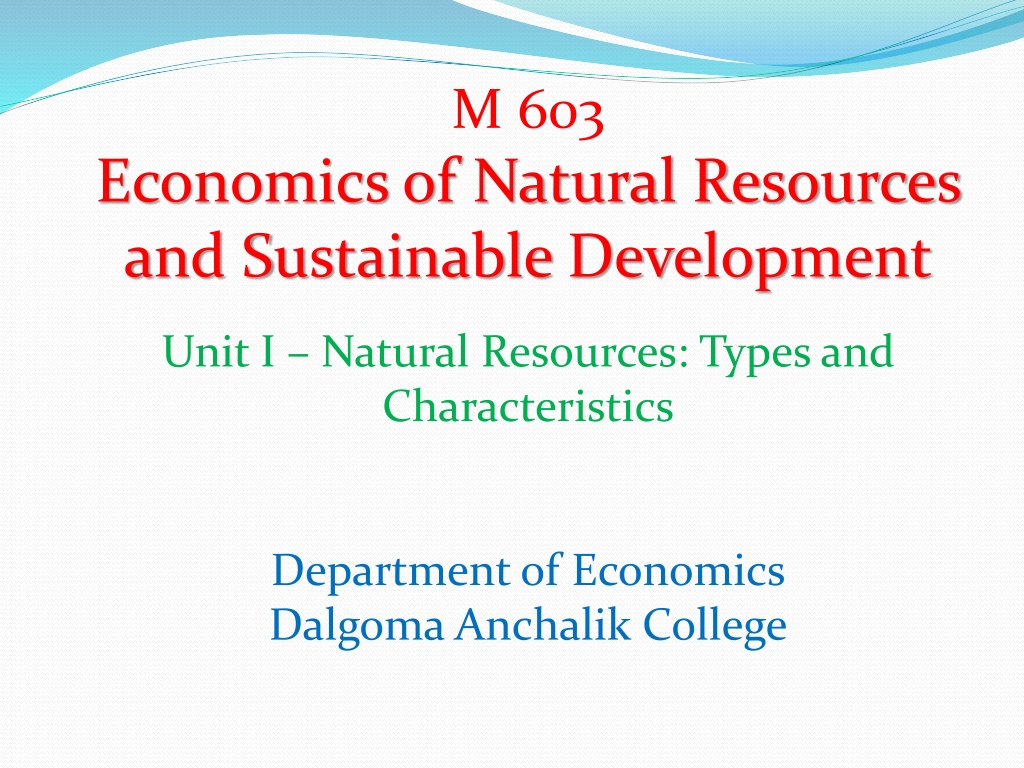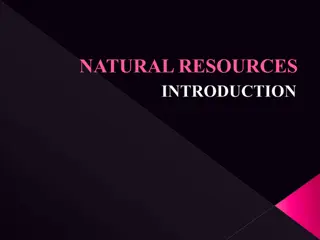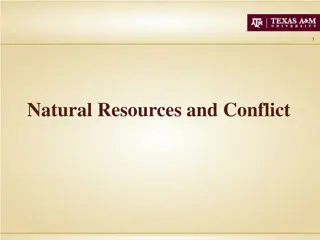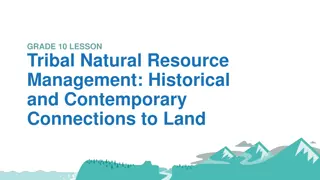Understanding Natural Resources and Resource Economics
Economics of natural resources focuses on the supply, demand, and sustainable allocation of the Earth's resources. It aims to develop a sustainable economy that protects natural resources for future generations. Natural resources are essential for human survival and include biotic and abiotic resources, such as forests, animals, fossil fuels, minerals, and sunlight. Learning about natural resources is crucial for developing sustainable methods to manage and preserve them.
Download Presentation

Please find below an Image/Link to download the presentation.
The content on the website is provided AS IS for your information and personal use only. It may not be sold, licensed, or shared on other websites without obtaining consent from the author. Download presentation by click this link. If you encounter any issues during the download, it is possible that the publisher has removed the file from their server.
E N D
Presentation Transcript
M 603 Economics of Natural Resources and Sustainable Development Unit I Natural Resources: Types and Characteristics Department of Economics Dalgoma Anchalik College
Natural Resource Economics Natural resource economics focuses on the supply, demand, and allocation of the Earth s natural resources. It s goal is to gain a better understanding of the role of natural resources in the economy. Learning about the role of natural resources allows for the development of more sustainable methods to manage resources and make sure that they are maintained for future generations. The goal of natural resource economics is to develop an efficient economy that is sustainable in the long-run. Importance of the Environment: This diagram illustrates how society and the economy are subsets of the environment. It is not possible for societal and economic systems to exist independently from the environment. For this reason, natural resource economics focuses on understanding the role of natural resources in the economy in order to develop a sufficient and sustainable economy that protects natural resources.
What are Natural Resources? Natural resources can be defined as the resources that exist (on the planet) independent of human actions. These are the resources that are found in the environment and are developed without the intervention of humans. Common examples of natural resources include air, sunlight, water, soil, stone, plants, animals and fossil fuels. Natural resources are naturally occurring materials that are useful to man or could be useful under conceivable technological, economic or social circumstances or supplies drawn from the earth, supplies such as food, building and clothing materials, fertilizers, metals, water and geothermal power. For a long time, natural resources were the domain of the natural sciences.
What are Natural Resources? Natural resources refer to the things that exist freely in nature for human use and don t necessarily need the action of mankind for their generation or production. The key aspect of natural resources is that they dictate the survival of humans and other life forms on earth. These resources include land, rocks, forests (vegetation), water (ocean, lakes, streams, seas, and rivers), fossil fuel, animals (fish, wild life, and domesticated animals), minerals, sunlight and air.
Types of Natural Resources Natural resources are derived from the environment. Some of the resources are essential to survival, while others merely satisfy societal wants. Every man-made product in an economy is composed of natural resources to some degree. There are numerous ways to classify the types of natural resources, they include the source of origin, the state of development, and the renewability of the resources. In terms of the source of origin, natural resources can be divided into the following types: Biotic: these resources come from living and organic material, such as forests and animals, and include the materials that can be obtained them. Biotic natural resources also include fossil fuels such as coal and petroleum which are formed from organic matter that has decayed. Abiotic: these resources come from non-living and non-organic material. Examples of these resources include land, fresh water, air, and heavy metals (gold, iron, copper, silver, etc.). Natural resources can also be categorized based on their stage of development including:
Potential resources: these are resources that exist in a region and may be used in the future. For example, if a country has petroleum in sedimentary rocks, it is a potential resource until it is actually drilled out of the rock and put to use. Actual resources: these are resources that have been surveyed, their quantity and quality has been determined, and they are currently being used. The development of actual resources is dependent on technology. Reserve resources: this is the part of an actual resource that can be developed profitably in the future. Stock resources: these are resources that have been surveyed, but cannot be used due a lack of technology. An example of a stock resource is hydrogen. Natural resources are also classified based on their renewability: Renewable natural resources: these are resources that can be replenished. Examples of renewable resources include sunlight, air, and wind. They are available continuously and their quantity is not noticeably affected by human consumption. However, renewable resources do not have a rapid recovery rate and are susceptible to depletion if they are overused. Non-renewable natural resources: these resources form extremely slow and do not naturally form in the environment. A resource is considered to be non- renewable when their rate of consumption exceeds the rate of recovery. Examples of non-renewable natural resources are minerals and fossil fuels.
Biotic and Abiotic Natural Resources a. Biotic natural resources The Biotic natural resources are the ones that come from the ecosphere (organic and living materials). These include resources such as animals, forests (vegetation), and other materials obtainable from them. Fossil fuels such as petroleum, oil, and coal are also included in this grouping because they are generated from decayed organic matter. b. Abiotic natural resources The abiotic natural resources are the ones that come from non-organic and non- living materials. Examples of abiotic natural resources are water, land, air and heavy metals like iron, copper, silver, gold, and so on.
Nonrenewable Resources A nonrenewable resource is a natural substance that is not replenished with the speed at which it is consumed. It is a finite resource. Fossil fuels such as oil, natural gas, and coal are examples of nonrenewable resources. Humans constantly draw on the reserves of these substances while the formation of new supplies takes eons. Renewable Resources Renewable resources are the opposite: Their supply replenishes naturally or can be sustained. The sunlight used in solar power and the wind used to power wind turbines replenish themselves. Timber reserves can be sustained through replanting. Understanding Nonrenewable Resources Nonrenewable resources come from the Earth. Humans extract them in gas, liquid, or solid form and then convert them for their use, mainly related to energy. The reserves of these substances took billions of years to form, and it will take billions of years to replace the supplies used
What are non-renewable resources? Non-renewable resources are derived from the Earth. Importantly, they have a finite supply that can take billions of years to replenish. Among the most common examples of natural resources are crude oil, coal, uranium, and mineral sources such as gold. Historically, many non-renewables have been relatively cheap to extract. But as their supply continues to diminish, the cost of this extraction may rise in price, leading customers to use alternative sources, such as solar and wind energy. different types of nonrenewable resources? One subset of nonrenewable resources includes crude oil and natural gas. Both of these substances are made out of organic carbon material, depending on the form it takes after heating and compressing over time. Another form of nonrenewables are minerals, which includes gold, silver, and iron. Unlike crude oil and natural gas, these are quite difficult and expensive to extract. Meanwhile, different types of groundwater are nonrenewables when they do not replensih at their draining speed.
Non Renewable Resources Here is a list of 10 examples of non-renewable energy resources available out there in the world. Fossil fuels Crude Oil Coal Uranium Natural Gas Tar Sand Steel Phosphate Aluminum Ground Water























